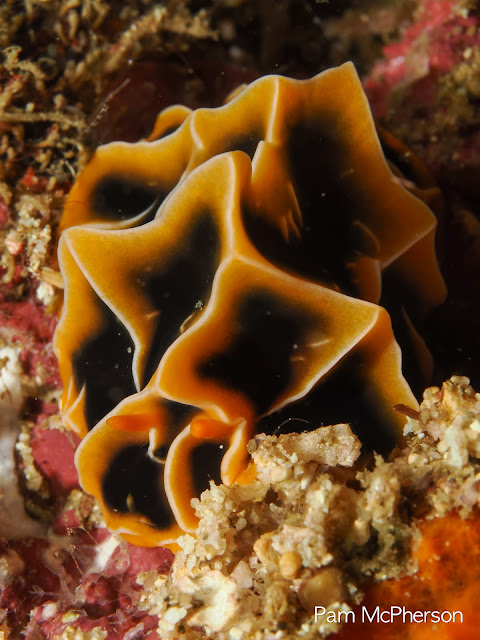Well, only two dives today and we are done. I am feeling pretty satiated. It is a LOT to try to keep it all together. A vacation like this is a lot of work.
I came down to the lecture room and got a good scolding from Jim. Not only were our species due by midnight last night, we’ve been doing it all wrong. We were supposed to put ALL the species seen on each dive. Jim is going to send me a digital spreadsheet so that I can do it completely. Professor Terry officially gave me an extension.
Jim was probably in a bad mood because the resort doesn’t have an egg cup for his boiled egg. They finally got one and he used it for one day. The staff then promptly threw it away. I told him that he should travel with his own. I mean it’s a pretty small item.
We need to submit our final data for Jim and up to 10 images for slideshow by 2:30pm. Yikes.
At the morning session, I learned that I identified the Siphopteron flavolineatum incorrectly. This is a Siphopteron nakakatuwa which I was told means cute in Tagalog. But after looking it up, it means “funny • humorous • ridiculous • causing laughter • laughable • jocose • witty • comical”. Flagellum is the name for the thing in the back.
We have also been talking about identifying Ceratosomas… which I have been calling the ones with the Brazilian Butt Lift (BBL) because they have a raised part where their gills are.
Since we didn’t have Nudi Council yesterday, we had TWO days worth of photos to look thru. OMG… this session went on for so long.
Then we had our group picture taken. It’s always a challenge to get everyone together and we almost had one taken without Mike Miller. He is the reason we are all here diving.
The two last dives were great. I continued to find some new species.
I came back for lunch and the internet was out. I did my best to meet our deadline, using mostly photos that I already had on my computer. This Lightroom connected to the internet thing just sucks when the WiFi is down.
OMG. This was all too much pressure, and I had to come to my air conditioned room to be alone for a while. Sometimes I question: Is this really what I do on vacation?
I watched some downloaded shows and then sat with Pirjo to help her set up Custom modes on her camera like mine. I figured it wasn’t going to be hard, but then I realized all of her settings were in French! We did it though.
Hannah, Geogina and Anouk came to the cocktail hour with the cutest nudi costumes! I was a little jealous that I wasn’t on their boat all week. Maybe we can do a trip together in the future.
I wasn't as fancy, but I did wear my nudi scarf, headband and two nudi necklaces!

Dinner was so delicious and they created some beautiful nudibranch cupcakes.
The slideshow afterward that Mike put together with our pictures was great.
The big reveal was that we didn’t beat our numbers of unique species from other years, but we DID have a huge number of brand new to the region and new to science. SEVENTEEN!!! I am so glad to have made it to this one and I am already excited for 2027.
We found 17 species that are completely new to science. Wow!
I said goodbye to everyone tonight, because tomorrow I leave at 6am for Manila.
Here are the final findings…
164 - Ceratodoris kendi
165 - Tenellia sibogae
166 - Dermatobranchus funiculus
167 - Hypselodoris nigrostriata
168 - Cratena simba
169 - Dermatobranchus sp. 6






















































